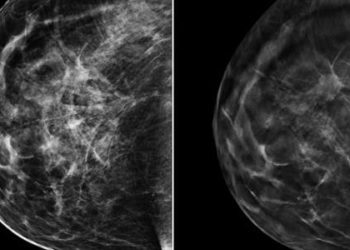Waist circumference, approximated by skirt size, linked to breast cancer risk
1. An increase in skirt size by one unit every 10 years, between mid-20s and post-menopausal years, was associated with a 33% increased risk of post-menopausal breast cancer.
2. For each unit increase in skirt size over 10 years, the five-year absolute risk for post-menopausal breast cancer increased from 1 in 61 women, to 1 in 51 women.
Evidence Rating Level: 2 (Good)
Study Rundown: There is growing evidence that anthropometric measurements, such as body mass index (BMI) and waist circumference, are associated with breast cancer risk. Studies have also demonstrated that weight change over time may be associated with breast cancer risk. One simple, reliable proxy measure of waist circumference is clothing size. This prospective cohort study, a substudy of the UK Collaborative Trial of Ovarian Cancer Screening (UKCTOCS), evaluated the association of change in skirt size over time and the risk of breast cancer. It was found that for each unit increase in skirt size (i.e. from size 10 to size 12) per 10 years, from the mid-20s to post-menopausal age, the risk of post-menopausal breast cancer increased by 33%. Additionally, a decrease in skirt size was associated with lower post-menopausal breast cancer risk.
The large sample size and comprehensive data that include complete information on established contributors to breast cancer risk, strengthen the validity of the results. Additionally, the results support existing evidence, and the investigation of a simple measure such as skirt size allows for potentially easier-to-understand messaging to the general public. However, the study was limited by the relatively short follow-up time, in that all cases of breast cancer may not have been detected by the end of the study period. Further, a measure such as skirt size is subject to underestimation and recall bias. Although such bias would be expected uniformly across the sample, the hazard ratio may have possibly been smaller. Considered overall, these data provide evidence that increase in skirt size between the mid-20s to post-menopausal years is associated with elevated post-menopausal breast cancer risk, and validation of these results may allow for more effective risk communication to the general public.
Click to read the study in BMJ Open
Relevant Reading: Central obesity and breast cancer risk
In-Depth [prospective cohort]: This study, conducted within the UKCTOCS trial, evaluated the effect of change in skirt size over time on the risk of breast cancer in post-menopausal women age >50. Participants were asked to report their current skirt size as well as at 25 years of age. The final analysis included 92,834 women, median follow-up of 3.19 years, of which 1090 (1.2%) developed breast cancer. Cox proportional hazard regression models were used to determine risk of breast cancer, adjusting for a variety of established confounders. A sensitivity analysis refitting the full regression model with a time-lag of 1 year was performed to account for the possibility of reverse causality (i.e. the possibility that preclinical breast cancer caused weight gain). After adjustment for confounders such as oral contraceptive use, hormone replacement therapy, number of pregnancies, and socioeconomic variables, increase in skirt size was the strongest predictor of increased breast cancer risk (hazard ratio 1.33 per 10 years, CI95% 1.12-1.58). Measures of adiposity such as BMI and skirt size at study entry also had a lesser association with breast cancer after adjustment. When BMI was included in the full model with change in skirt size, it was noted that change in skirt size remained significantly associated with breast cancer risk (HR 1.27, CI95% 1.0411.54), independent of BMI (HR 1.04, CI95% 0.97-1.11).
More from this author: Risk of cerebral palsy linked with relatedness to cerebral palsy patient, Active commuting associated with a lower BMI, body fat, Association of obesity and dementia varies with age, Decrease in sedentary lifestyle associated with longer telomere length
Image: PD
©2012-2014 2minutemedicine.com. All rights reserved. No works may be reproduced without expressed written consent from 2minutemedicine.com. Disclaimer: We present factual information directly from peer reviewed medical journals. No post should be construed as medical advice and is not intended as such by the authors, editors, staff or by 2minutemedicine.com. PLEASE SEE A HEALTHCARE PROVIDER IN YOUR AREA IF YOU SEEK MEDICAL ADVICE OF ANY SORT.







